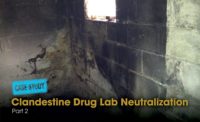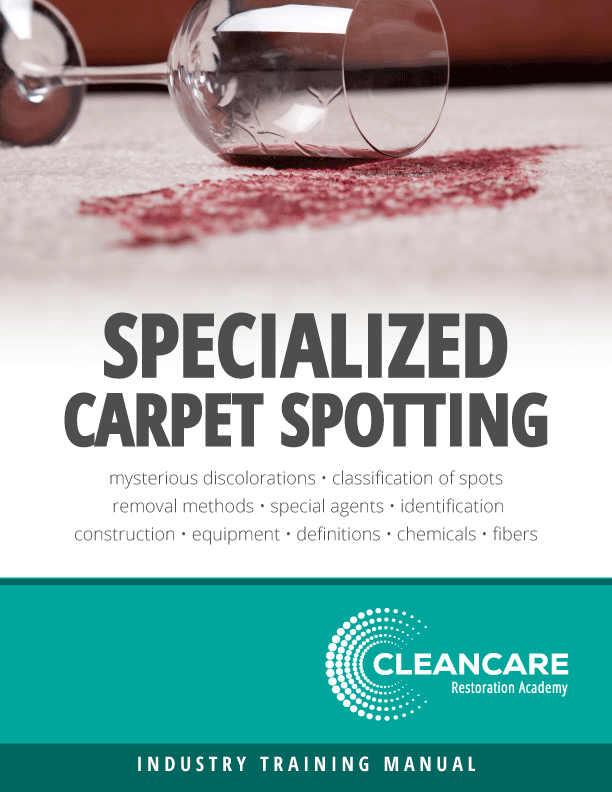Case Study: Drug Lab Cleanup | Part 1

Tools left onsite. Photos courtesy of Meth Lab Cleanup Company
During the methamphetamine manufacturing process, chemical compounds become airborne (volatilized) and settle out, depositing onto walls, into heating/cooling units, ceilings, appliances, floors, carpets, and other typical household items throughout the building’s interior. In addition, chemicals used to make the illegal drugs may be spilled during handling or during the manufacturing process. The presence of these chemicals may pose health threats to building occupants and potential liability to property owners.

Discarded building materials.
Twenty-eight states regulate clandestine drug lab decontamination (in some form) of properties affected by the illegal manufacture of methamphetamine and for owners to have their property declared “fit for use” after being decontaminated. Although the decontamination process described by regulation differs somewhat state to state, there are standard methods to remove residual contamination from building interiors and standard methods to demonstrate that appropriate cleanup standards have been met via sampling and laboratory analyses. Decontamination activities pose the risk of potential exposure to hazardous substances and chemicals. Only certified clandestine laboratory contractors should offer services for the assessment and remediation of contaminated properties.
Many clandestine drug lab decontamination contractors are now claiming to be able to neutralize meth use and production contamination. To claim to be able to neutralize meth is usually an indicator that you are dealing with an inexperienced contractor. There are very few chemicals that can be used to completely destroy the meth molecule and can be very dangerous when not handled appropriately. They can also cause more damage to the property (corrosion). Also, there are no data regarding the affects these chemicals have on the other contaminants involved. In short, you do not know what is being left behind. In most cases, these chemicals will only break enough of the bonds of the marker (meth molecule) to render the meth non-detectable at the lab.

Garbage on a cleanup site.
Meth Lab Cleanup Company conducted a post-remedial assessment of at the residential property located at ABC Street, Pleasantville, OH for Ms. Claudia White. Of course identities and names of people and products in this case study have been altered in many cases. Services were provided at the request of the client to determine if the property has been decontaminated by a local contractor according to industry standards (the state where the residence is located is not yet regulated). The assessment was performed by certified clandestine drug lab technicians on January 14, 2013.

Duct work removed/discarded.
A. BACKGROUND - INITIAL DECONTAMINATION
On Jan. 27, 2012 police seized a meth lab at the residence. Joe Mazzuca, the operations manager at Meth Lab Cleanup Company was informed by Ms. White that the residence has been “treated” with a product called Grandma’s Secret Recipe by an Ohio based company. According to the decontamination contract, two products, Grandma’s Secret Recipe and MightyMight chemical products were applied. MightyMight was designed for the “neutralization” of bio hazards such as anthrax and other microbial organisms. This product is patented by a national laboratory and is sold to distributors under license agreements. The Material Safety Data Sheet (MSDS) for MightyMight is identical to that of Grandma’s Secret Recipe. The trade name/synonym listed on the Grandma’s Secret Recipe MSDS is MightyMight. In addition, research documents listed on a Grandma’s Secret Recipe distributor’s website are attributed to MightyMight; therefore, it can be assumed they are the same product (also sold as DeepPenetrator). Grandma’s Secret Recipe/MightyMight consists of three parts, which includes a penetrator, a quaternary ammonium product, a fortifier, liquid hydrogen peroxide and a booster, labeled as a diacetin on the MSDS.

Chemical residue on the ceiling.
According to the information provided to Ms. White by Mr. Brown and confirmed by contract, Grandma’s Secret Recipe/MightyMight was applied to all exposed surfaces by high-pressure spraying and foaming in the interior of the structure. It was also “fogged” into the central heat system ducting. Application of the product began Dec. 20, 2012. The product was first applied to the upstairs and half of the main level of the residence. According to Ms. White, Mr. Brown’s equipment then malfunctioned and the application stopped. The crew returned to the property on Jan. 6, 2013 to apply the product to the other half of the main level, the basement and the HVAC duct work.

Debris on windowsill.
Evidence of the Grandma’s Secret Recipe/MightyMight chemical still remained, jelled on the walls, ceilings and fixtures; approximately 32 days after the initial application, 15 days after the second application (yet to be removed). Chemical residue remains on all horizontal and vertical surfaces throughout the structure. The chemical layer on the floors made it difficult for the technicians to walk the interior; the application has created an Occupational Safety & Health (OSHA) slip and fall hazard. Paint is beginning to peel from the walls due to both over saturation and the standing chemical. A warning on a distributor’s website states “Depending on the condition of the drywall or plaster painted surface after applying Grandma’s Secret Recipe some areas could bubble or blister. Most do NOT do this, but drywall or plaster with cheap paint could result in some minor drywall repairs after the application of Grandma’s Secret Recipe.” In all states that regulate clandestine drug lab decontamination, at least a two-cycle detergent washing and rinse process is required on all surfaces (most states require three). For example, Utah Administrative Code, R392 (12): “Cleaning Procedure. For all items, surfaces or materials that are identified as easily cleanable and for which the work plan indicates they will be decontaminated on site, the decontamination specialist or owner of record shall wash them with a detergent and water solution and then thoroughly rinse them. This procedure shall be repeated at least two additional times using new detergent solution and rinse water. The decontamination specialist or owner of record shall test all surfaces where decontamination on site has been attempted to verify compliance with the decontamination standards in R392-600-6(2) and R392-600-6(3).”

Unsecured wiring.
As stated on the distributor’s website, “After one-hour dwell time, Grandma’s Secret Recipe is removed with fresh water.” It was evident to the Meth Lab Cleanup Company technicians that the surfaces “treated” with the chemical were not rinsed. The chemical product streaked through residue (both filth and potential drug production related) on the walls creating black stripes. Yellowish bubbles were dripping and congregating on the ceilings and other surfaces. It is also evident that high energy particulate air (HEPA) vacuuming did not take place prior to the treatment (an industry standard). In addition, the sheetrock in the painted rooms was not removed prior to the chemical application; a standard practice for areas where contamination has been encapsulated. Meth residue has been shown to migrate through painted surfaces; dependent on the type of paint and the application process.

Compromised building materials.
In part two of this short series appearing in the August issue, learn how Meth Lab Cleanup Company remediated all these issues, and techniques to effectively remediate illicit drug labs today.

Unremoved water heater cover.
Looking for a reprint of this article?
From high-res PDFs to custom plaques, order your copy today!






